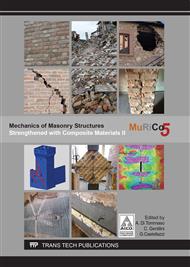[1]
Pellegrino C, Vasic M. Assessment of design procedures for the use of externally bonded FRP composites in shear strengthening of reinforced concrete beams. Compos Part B Eng 2013; 45: 727–41.
DOI: 10.1016/j.compositesb.2012.07.039
Google Scholar
[2]
Triantafillou TC, Papanicolaou CG. Shear strengthening of reinforced concrete members with textile reinforced mortar (TRM) jackets. Mater Struct Constr 2006; 39: 93–103.
DOI: 10.1007/s11527-005-9034-3
Google Scholar
[3]
Al-Salloum Y, Elsanadedy HM, Alsayed SH, Iqbal RA. Experimental and numerical study for the shear strengthening of reinforced concrete beams using textile-reinforced mortar. J Compos Constr 2012; 16: 74–90.
DOI: 10.1061/(asce)cc.1943-5614.0000239
Google Scholar
[4]
Brückner A, Ortlepp R, Curbach M. Textile reinforced concrete for strengthening in bending and shear. Mater Struct 2006; 39: 741–8. doi: 10. 1617/s11527-005-9027-2.
DOI: 10.1617/s11527-005-9027-2
Google Scholar
[5]
Ombres L. Structural performances of PBO FRCM-strengthened RC beams. Proc ICE - Struct Build 2011; 164: 265–72.
DOI: 10.1680/stbu.2011.164.4.265
Google Scholar
[6]
Bournas D, Triantafillou T, Zygouris K, Stavropoulos F. Textile-Reinforced Mortar versus FRP Jacketing in Seismic Retrofitting of RC Columns with Continuous or Lap-Spliced Deformed Bars. J Compos Constr 2009; 13: 360–71. doi: 10. 1061/(ASCE)CC. 1943-5614. 0000028.
DOI: 10.1061/(asce)cc.1943-5614.0000028
Google Scholar
[7]
Babaeidarabad S, Arboleda D, Loreto G, Nanni A. Shear strengthening of un-reinforced concrete masonry walls with fabric-reinforced-cementitious-matrix. Constr Build Mater 2014; 65: 243–53. doi: 10. 1016/j. conbuildmat. 2014. 04. 116.
DOI: 10.1016/j.conbuildmat.2014.04.116
Google Scholar
[8]
Santandrea M, Imohamed IAO, Carloni C, Mazzotti C, Miranda S De, Ubertini F. A study of the debonding mechanism in steel and basalt FRCM-masonry joints. Int. Brick Block Mason. Conf., Padua, Italy: 2016, p.433–40.
DOI: 10.1201/b21889-52
Google Scholar
[9]
ACI Committee 549. Guide to design and construction of externally bonded Fabric-Reinforced Cementitious Matrix (FRCM) systems for Repair and Strengthening Concrete and Masonry Structures. ACI549R-13. Farmington Hills, MI.: (2013).
DOI: 10.1016/j.prostr.2018.11.027
Google Scholar
[10]
D'Antino T, Papanicolaou C. Mechanical characterization of textile reinforced inorganic-matrix composites. Compos Part B Eng 2017. doi: 10. 1016/j. compositesb. 2017. 02. 034.
Google Scholar
[11]
D'Antino T, Carloni C, Sneed LH, Pellegrino C. Matrix-fiber bond behavior in PBO FRCM composites: A fracture mechanics approach. Eng Fract Mech 2014; 117: 94–111. doi: 10. 1016/j. engfracmech. 2014. 01. 011.
DOI: 10.1016/j.engfracmech.2014.01.011
Google Scholar
[12]
D'Ambrisi A, Feo L, Focacci F. Experimental and analytical investigation on bond between Carbon-FRCM materials and masonry. Compos Part B Eng 2013; 46: 15–20. doi: 10. 1016/j. compositesb. 2012. 10. 018.
DOI: 10.1016/j.compositesb.2012.10.018
Google Scholar
[13]
D'Ambrisi A, Feo L, Focacci F. Experimental analysis on bond between PBO-FRCM strengthening materials and concrete. Compos Part B Eng 2013; 44: 524–32. doi: 10. 1016/j. compositesb. 2012. 03. 011.
DOI: 10.1016/j.compositesb.2012.03.011
Google Scholar
[14]
Sneed LH, D'Antino T, Carloni C. Investigation of bond behavior of polyparaphenylene benzobisoxazole fiber-reinforced cementitious matrix composite-concrete interface. ACI Mater J 2014; 111: 569–80. doi: 10. 14359/51686604.
DOI: 10.14359/51686604
Google Scholar
[15]
Sneed LH, Verre S, Carloni C, Ombres L. Flexural behavior of RC beams strengthened with steel-FRCM composite. Eng Struct 2016; 127.
DOI: 10.1016/j.engstruct.2016.09.006
Google Scholar
[16]
Carozzi FG, Colombi P, Fava G, Poggi C. A cohesive interface crack model for the matrix-textile debonding in FRCM composites. Compos Struct 2016; 143: 230–41. doi: 10. 1016/j. compstruct. 2016. 02. 019.
DOI: 10.1016/j.compstruct.2016.02.019
Google Scholar
[17]
Yao J, Teng JG, Chen JF. Experimental study on FRP-to-concrete bonded joints. Compos Part B Eng 2005; 36: 99–113. doi: 10. 1016/j. compositesb. 2004. 06. 001.
DOI: 10.1016/j.compositesb.2004.06.001
Google Scholar
[18]
J.F. Chen & J.G. Teng. Anchorage Strength Models for FRP and Steel Plates. J Struct Eng 2001; 127: 784–91.
DOI: 10.1061/(asce)0733-9445(2001)127:7(784)
Google Scholar
[19]
D'Antino T, Sneed LH, Carloni C, Pellegrino C. Effect of the inherent eccentricity in single-lap direct-shear tests of PBO FRCM-concrete joints. Compos Struct 2016; 142: 117–29. doi: 10. 1016/j. compstruct. 2016. 01. 076.
DOI: 10.1016/j.compstruct.2016.01.076
Google Scholar
[20]
D'Antino T, Pellegrino C. Bond between FRP composites and concrete: Assessment of design procedures and analytical models. Compos Part B Eng 2014; 60: 440–56. doi: 10. 1016/j. compositesb. 2013. 12. 075.
DOI: 10.1016/j.compositesb.2013.12.075
Google Scholar
[21]
COMITE EUROPEEN DE NORMALIZATION. Methods of test for mortar for masonry - Part 11: determination of flexural and compressive strength of hardened mortar 2007: UNI EN 1015-11.
DOI: 10.3403/01905442
Google Scholar
[22]
G&PIntech. Technical datasheets 2017. http: /www. gpintech. com/ (accessed January 19, 2017).
Google Scholar
[23]
ASTM INTERNATIONAL. Standard test method for tensile properties of polymer matrix composite materials 2008: ASTM D3039/D3039M-08.
Google Scholar
[24]
EN-12390-3. Testing hardened concrete-Part 3: Compressive strength of test specimens. Brussels, Belgium: EUROPEAN COMMITTEE FOR STANDARDIZATION; (2009).
Google Scholar
[25]
Terreal San Marco. Technical datasheet n. d. http: /www. sanmarco. it/index. php/faccia-vista/classico (accessed January 19, 2017).
Google Scholar


